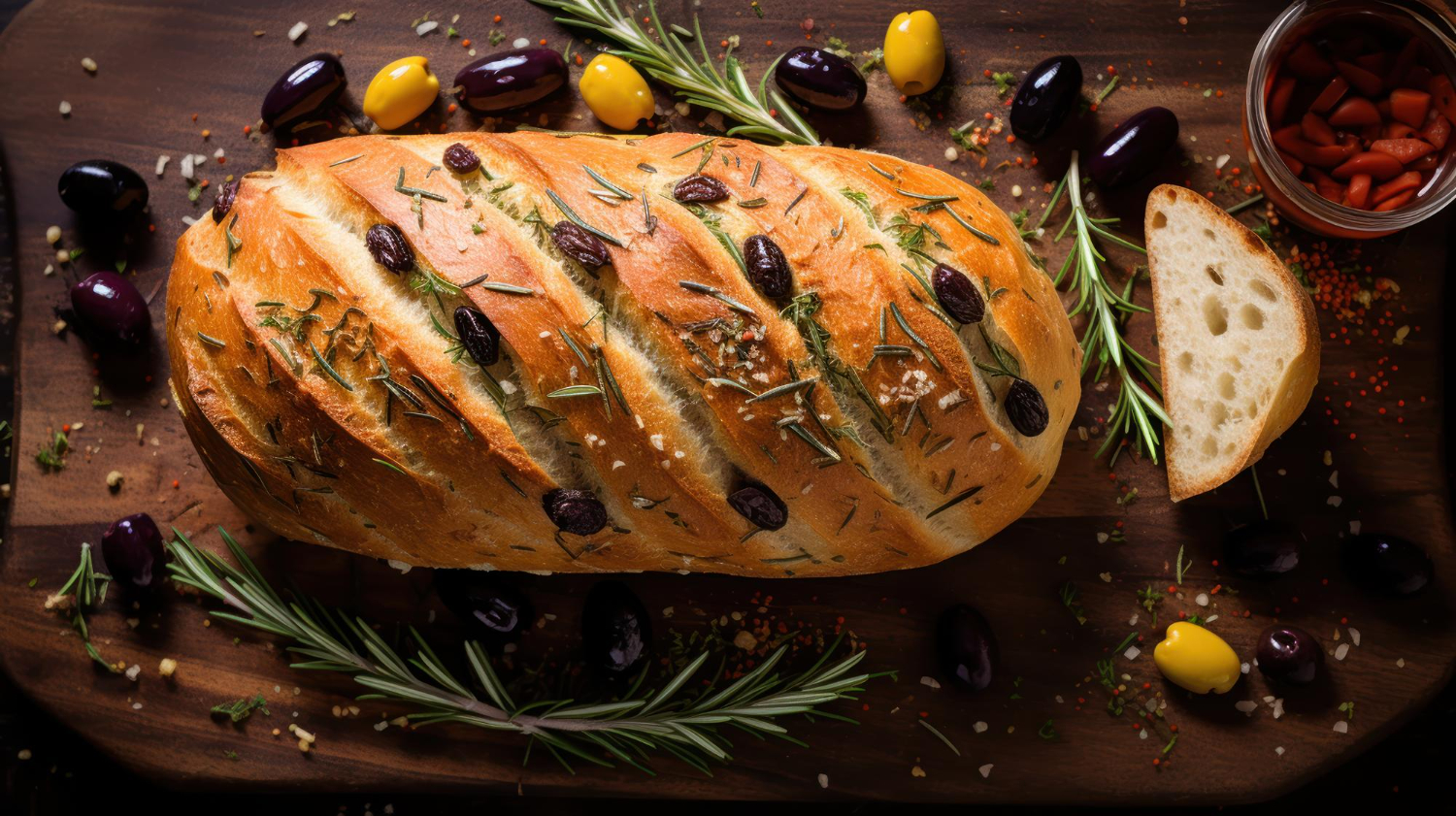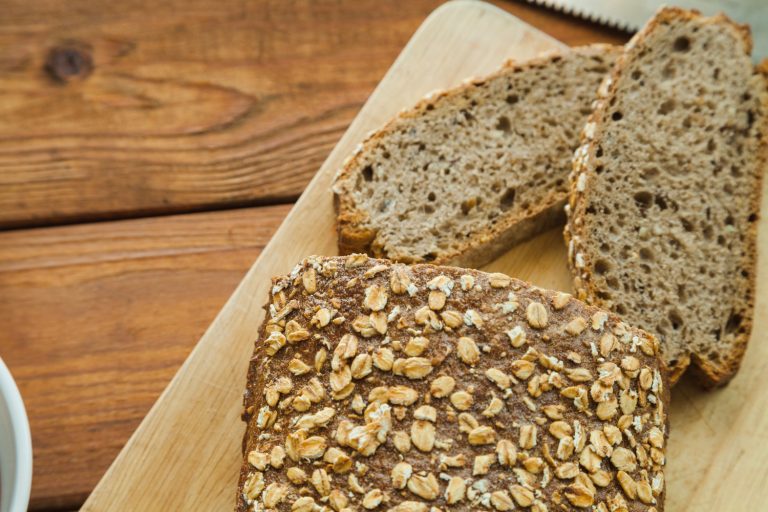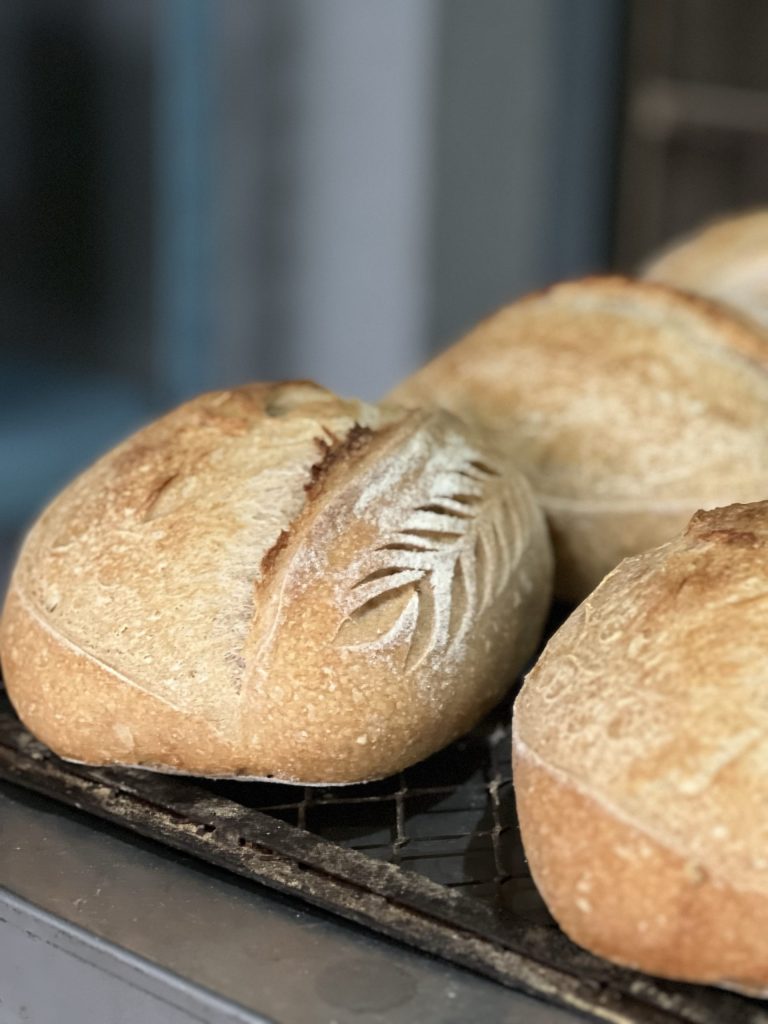How to Bake Authentic Greek Olive Sourdough Bread at Home
Greeks lead Europe in bread consumption, with each person eating an impressive 68 kg annually.
The magical aroma of freshly baked Greek olive sourdough bread fills your kitchen with warmth and anticipation. Store-bought versions might be convenient, but they can’t match the pure satisfaction of pulling your own crusty, olive-studded loaf from the oven.
Our team has refined this olive sourdough recipe over the last several years. We combined traditional Greek baking methods with modern sourdough techniques to create a reliable approach. The result produces authentic Greek sourdough bread that matches any Mediterranean bakery.
With this timeless recipe, your kitchen can become a Greek bakery. Let’s examine the ingredients and techniques you’ll need to create your perfect loaf.
Essential Ingredients for Authentic Greek Olive Bread
The ingredients make authentic Greek olive sourdough bread special. Years of baking have taught us that success depends on careful ingredient selection and combination.
Choosing the Right Olives: Kalamata vs Other Varieties
A perfect Greek olive sourdough combines Kalamata and Castelvetrano olives. Kalamata olives provide a rich, fruity, slightly tangy profile that creates authentic Greek flavor. These olives pair beautifully with mild, buttery Castelvetrano olives to create an ideal balance. The best results come from:
- ½ cup Kalamata olives (pitted and roughly chopped)
- ½ cup Castelvetrano olives (pitted and roughly chopped)
Selecting Quality Flour and Salt
Quality flour and salt selection are the foundations of Greek olive sourdough. Our research about flour protein content shows:
| Flour Type | Protein Content | Best Used For |
|---|---|---|
| Bread Flour | 12-14% | Main dough base |
| All-Purpose | 10-12% | Starter feeding |
| Whole Wheat | 13-15% | Flavor enhancement |
Unbleached flour works best because bleaching eliminates the natural yeasts needed for sourdough fermentation. Kosher salt at 1.2-2% of total flour weight creates a perfect balance and enhances flavors while controlling fermentation.
Building a Strong Sourdough Starter
A perfect starter needs consistency. Our starter maintains 100% hydration with equal parts flour and filtered water by weight. The optimal feeding routine uses:
- 70g medium-protein white flour
- 30g whole-grain rye flour
- 100g filtered water
- 20g mature starter
Rye flour plays a significant role in maintaining a vigorous starter by providing extra nutrients for wild yeast and beneficial bacteria. This combination produces a starter strong enough to leaven bread and add complex flavors that complement the olives.
Traditional Greek Bread-Making Techniques
Now that we’ve become skilled at selecting quality ingredients let’s take a closer look at the techniques that make Greek olive sourdough bread exceptional. Our experience in traditional Greek bakeries and modern kitchens has taught us that success comes from understanding and respecting these proven methods.
Understanding Greek Bakery Methods
Temperature control is crucial in traditional Greek baking. The dough needs to stay at 78°F/25.5°C during fermentation. This creates the perfect environment for flavor development. The distinctive village bread (Horiatiko psomi) texture comes from a unique blend of slow fermentation and proper dough handling.
Proper Dough Hydration Levels
Our test batches have helped us perfect the hydration ratios. Here’s what works best:
| Hydration Level | Result | Best For |
|---|---|---|
| 65% | Easier handling | Beginner bakers |
| 75% | Softer crumb | Intermediate level |
| 78% | Open crumb structure | Advanced bakers |
Starting at 65% hydration helps you learn the techniques before trying higher hydration levels. The hydration needs to be slightly lower when adding olives to account for their moisture content.
Hand Kneading vs Machine Mixing
Hand kneading remains our preference for olive sourdough despite the convenience of modern stand mixers. Here’s why:
- Better control over olive distribution
- A natural feel for dough development
- Deeper connection with traditional methods
Our favorite kneading approach combines stretch-and-fold methods with 30-minute intervals. This gentle technique prevents olive damage while developing proper gluten structure. If using a machine, the dough hook works best at medium-low speed. To keep the olives intact, add them for the final two minutes. Success in kneading comes from knowing when the dough is ready. The “window pane test” shows us when the dough stretches thin enough to see light through without tearing. This usually takes 10-15 minutes by hand or 5-7 minutes by machine.
Note that these techniques require practice and patience. The dough should feel alive under your hands—responsive and elastic, not sticky or tough. This texture signals that you’re on track to create authentic Greek olive sourdough bread.
Mastering the Olive Integration Process
The art of integrating olives into our sourdough bread combines science and tradition in Greek baking. We found that successful olive integration goes beyond mixing ingredients. It needs perfect timing, technique, and a delicate balance of moisture.
Preparing and Curing Olives
Olive preparation is a vital step in creating the perfect Greek olive sourdough. We rinse our olives well and pat them dry to remove excess brine. These preparation ratios give optimal results:
| Olive Type | Preparation Method | Drying Time |
|---|---|---|
| Kalamata | A quick rinse, pat dry | 15 minutes |
| Mixed varieties | Gentle wash, air dry | 20 minutes |
| Brined olives | Double rinse, thoroughly dry | 25 minutes |
Optimal Timing for Adding Olives
Our test batches helped us perfect the timing of olive integration. Using the stretch-and-fold technique, the olives go 30-45 minutes into the bulk fermentation process. Here’s what works best:
- First fold: Incorporate 50% of prepared olives
- Second fold: Add the remaining 50% for even distribution
- Final fold: Check for any exposed olives and tuck them in
Preventing Olive Moisture Issues
Moisture management plays a key role when working with olives in sourdough. These techniques help prevent moisture-related problems:
Pre-drying Process: Clean kitchen towels help pat our olives dry before incorporation. This stops excess moisture from affecting dough hydration.
Strategic Placement: The folding process ensures olives stay fully encased in dough to prevent surface breakage during baking.
Hydration Adjustment: With juicy olives, our base recipe’s hydration drops by 2-3%, helping maintain perfect dough consistency.
Plump, juicy olives work as natural steam injectors during baking, creating a wonderfully soft and tender crumb. Well-integrated olives enhance flavor and the bread’s texture while helping with moisture retention.
Note that olives might pop out during shaping, so tuck them back into the dough. Each fold presents a chance to ensure that the turf loaf is evenly distributed with olives.
Perfecting the Fermentation Process
Temperature control is the lifeblood of successful fermentation in our Greek olive sourdough bread. We found that becoming skilled at this vital phase revolutionizes a good loaf into an exceptional one. The result is a perfect crumb structure and complex flavors that blend with our carefully merged olives.
Bulk Fermentation Guidelines
Our dough performs best at 75-78°F (24-25°C) during bulk fermentation. Temperature directly impacts our fermentation timeline:
| Temperature | Bulk Fermentation Duration |
|---|---|
| 75°F (24°C) | 4 to 4.5 hours |
| 78°F (25°C) | 3.5 to 4 hours |
| 80°F (26°C) | 3 to 3.5 hours |
The bulk fermentation process requires three sets of stretch and folds spaced 30 minutes apart. After the final fold, the dough needs to rest covered until bulk fermentation is complete.
Cold Proofing Techniques
Cold-proofing (retarding) our olive sourdough yields exceptional results. Our process shows:
- Minimum 5 hours in the refrigerator
- Maximum 36 hours to develop optimal flavor
- Temperature stays steady at 38-40°F (3-4°C)
Through this extended cold fermentation, beautiful blisters appear on our crust. The sourdough flavor deepens and pairs perfectly with our briny olives.
Reading Dough Temperature Signals
Monitoring dough temperature leads to consistent results. An instant-read thermometer helps us check our dough at specific points:
- Original Mix: The final dough temperature (FDT) should reach 75-78°F
- During Bulk: Each stretch and fold requires a temperature check
- Pre-Shaping: The dough shouldn’t overheat during fermentation
The dough needs 15-30 minutes in the refrigerator if it exceeds 80°F (26°C). A warmer spot in the kitchen helps if the dough feels too cold until it hits the right temperature.
Perfect fermentation shows when the dough doubles in size with large air bubbles beneath the surface. The dough should feel alive and wobbly but maintain its structure. These visual and tactile signs, plus precise temperature control, help us create consistent, professional-quality Greek olive sourdough bread.
Authentic Greek Baking Methods
Becoming skilled at Greek-style baking demands precision, patience, and the right equipment. Our testing over the last several years has helped us perfect a method to recreate authentic Greek bakery results in your home kitchen.
Traditional Oven Techniques
Our experience of perfecting Greek olive sourdough bread showed us that a Dutch oven or combo cooker gives that distinctive village bread texture. The Dutch oven needs to preheat at 500°F (260°C) for a full hour to create intense heat, similar to traditional wood-fired ovens.
The best results come from this two-stage baking process:
- First stage: 20 minutes with the lid on at 450°F (230°C)
- Second stage: 30-35 minutes with the lid removed for crust development
A pocket of steam forms during the covered first stage, giving the oven spring and crust a beautiful appearance. This method consistently produces bread that matches traditional Greek village bakeries.
Creating Perfect Crust Texture
Proper steam and temperature control give Greek bread its coveted crust. The Dutch oven works like a miniature steam oven, ensuring even rising and perfect browning.
Temperature Guidelines for Crust Development:
| Baking Stage | Temperature | Duration | Purpose |
|---|---|---|---|
| Original Bake | 450°F/230°C | 20 min | Steam development |
| Final Bake | 450°F/230°C | 30-35 min | Crust formation |
The perfect crust should be thin and brittle and beautiful golden-brown in color. Olives on the surface create an artistic pattern that hints at flavors inside. Tapping an adequately baked loaf indicates a perfect internal structure; a hollow sound comes from tapping it.
Achieving Proper Internal Temperature
Our testing shows that internal temperature is vital for perfectly baked Greek olive sourdough. Target temperatures vary based on desired results:
- 190°F (88°C): Standard doneness for soft, moist crumb
- 195°F (90°C): Ideal for olive-enriched dough
- 205°F (96°C): For denser, more rustic texture
Visual cues work alongside temperature readings. Look for an intensely colored crust; the bread should feel light for its size. Temperature readings are helpful, especially with olive-enriched d, since moisture content can vary.
The pot-and-lid combination creates an ideal environment for bread. Steam stays trapped inside for 20 minutes to develop the characteristic crust while the bread rises. After removing the lid, dry heat transforms the crust into a beautiful, brittle shell, protecting the tender, olive-studded interior.
High-altitude bakers should reduce the target internal temperature by about 5°F to account for water’s lower boiling point. This adjustment gives consistent results regardless of location. Note that temperature readings help, but your baker’s instinct will grow as you learn to spot proper crust color and hear that hollow sound from tapping the bottom.
Conclusion
To perfect, Greek olive sourdough bread needs careful attention, patience, and practice. Our experience with traditional and modern methods shows that premium ingredients, becoming skilled at olive integration, and proper temperature control during fermentation lead to great results.
Your ingredients will make or break the bread – from well-chosen Kalamata olives to a healthy sourdough starter. The starter quality matters a lot. You can get an authentic artisanal sourdough starter from The Yeast We Can Do. Their premium starter gives your bread and pizza the perfect tangy flavor with signature crust characteristics. Reach out to john@theyeastwecando.com to enhance your baking.
Temperature control is vital during bulk fermentation and proofing. The perfect balance of flavor and texture comes from keeping 75-78°F during bulk fermentation with proper cold proofing. A two-stage baking process in a Dutch oven creates bread with a crackling crust and tender, olive-studded crumb that matches the quality of any Greek village bakery.
Watch your dough’s signals and practice these methods. Soon, you’ll create beautiful loaves that capture the essence of authentic Greek baking. Happy baking!
FAQs
How long should sourdough bread be baked in the oven?
Bake the sourdough bread for 20 minutes with steam. After that, release the steam or remove the lid and continue baking for 30 minutes. The bread is done when the internal temperature reaches approximately 204°F (95°C). Allow the loaves to cool on a wire rack for about two hours before slicing.
What is the shelf life of olive sourdough bread?
Olive sourdough bread typically remains fresh for about 3 to 5 days when stored at a moderate room temperature between 18-20°C (64-68°F). However ,the bread may spoil more quickly in warmer and more humid conditions
Is a special pan required for baking sourdough bread?
No special pan is needed to bake sourdough bread. The simple sourdough recipe YA can be baked in a metal or glass loaf pan.
Is baking your sourdough bread more economical?
The cost of baking a basic loaf of sourdough bread at home ranges from USD 1.00 to USD 2.00, depending on the type of flour used. The total expense can vary from USD 5.00 to USD 20.00 per loaf when considering additional costs such as time, labor, and energy.






